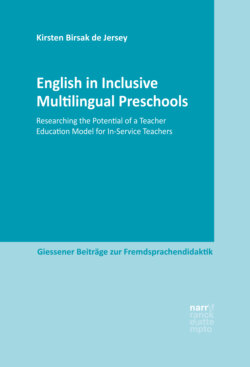Читать книгу English in Inclusive Multilingual Preschools - Kirsten Birsak de Jersey - Страница 10
2.2.2 Austrian education policy for the preschool level
ОглавлениеIn Austria the European Commission’s proposal to teach a foreign language at the preschool level became eclipsed by the responsibility and immediate need to focus on the language of instruction - German. The BildungsRahmenPlan, the preschool educational plan for Austria published by the Bundesministerium für Unterricht, Kunst und Kultur (2009a), was published with an extra component dedicated to early language learning which refers entirely and exclusively to German (Bundesministerium für Unterricht, Kunst und Kultur, 2009b). According to the European country report of Austria, the situation is as follows:
Austrian kindergartens further and promote children’s acquisition of the German language above all: this applies both to children with German as a first language, and to children who have a different first language. (Council of Europe, 2008a, p. 36)
Programmes designed to give children of kindergarten age a good start in primary school by ensuring that they have a sufficient level of competence in the language of schooling are high on the agenda of ministries of education and local education authorities. (Council of Europe, 2008b, p. 11)
The final version does not cater for foreign language learning in its early language learning programme. “Systematic foreign language teaching (FLT) at pre-primary level does not lie within the priorities of the Austrian education system” (European Commission, 2011b, p. 7) to the extent that foreign languages are not discussed at all within the compilation of the BildungsRahmenPlan. Foreign language learning was however included in the discussion in the draft of BildungsRahmenPlan. “Beim Fremdsprachenlernen im Kindergarten ist es häufig das vorrangige Ziel, eine Sprache kennenzulernen, die für alle Kinder neu ist. Durch Lieder, Reime, einfache Texte können Klangbild und Aussprache gefestigt werden” (Bundesministerium für Unterricht, Kunst und Kultur, 2008, p. 25). The BildungsRahmenPlan is significant for the implications of foreign language learning initiatives in Austrian state preschools, because it is the legal foundation for the education plan for all Austrian preschools.
The BildungsRahmenPlan was a turning point in the organisation of preschool education. Previously, Austria had a complicated political organisation for preschools because legislation and administration lay within the responsibility and discretion of nine independent federal states. To remedy the situation, the nine federal states signed a Memorandum of Understanding in 2008, which announced a “new legal basis for pre-school education to regulate responsibilities and cooperation between the Republic of Austria and its nine federal countries” (European Commission, 2011b, p. 4). This resulted in the publication of the BildungsRahmenPlan which was compiled in August 2009 (Bundesministerium für Unterricht, Kunst und Kultur, 2009a; 2009b). It did not explicitly rule out that English or any other foreign language could be included in preschools but placed responsibility on the individual preschools both to cater for and to finance any initiative that may take place with no official support provided. As a result, implementation of teaching a foreign language is scarce and varies greatly from preschool to preschool as is the case in other European member states (European Commission, 2011b, p. 9). Given this situation, no support for provision of a consistent foreign language learning curriculum or teacher education programmes that qualify preschool teachers appropriately, are provided. The Country Report referring to Austria simply states that more needs to be offered in the way of other languages in addition to German (Council of Europe, 2008a, p. 86). It would seem that Lower Austria was an exception; however, the financial support of this program was stopped in 2016:
In Niederösterreich, dem größten Bundesland Österreichs, wird Englisch flächendeckend schon im Kindergarten angeboten (vgl. Boeckmann et al. 2011). Außer dem Englischen bezieht dort die sprachliche Bildung ab der Elementarstufe die jeweiligen Nachbarsprachen (Tschechisch, Slowakisch, Ungarisch, Slowenisch, Italienisch) mit ein. Ferner ist vorgesehen … durch andere Familiensprachen, … [die] in der pädagogischen Einrichtung vertreten sind, die sprachlichen Erlebnisse der Kinder zu erweitern. (Sambanis, 2016, p. 173)
My research therefore addresses this situation in early foreign language education through an empirical study that has been conducted in a state preschool. This context can be said to be representative of many state preschools in Salzburg (→ chapter 6.2). The next section will give a more detailed insight in the preschool teacher education in Austria.
